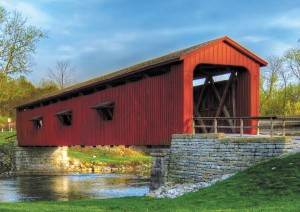The fall Sundays of my preteen years followed a format. Church with the family, one of Mom’s fried chicken dinners, and then everyone piled into Dad’s ‘57 Chevy and off we would go for a drive in the country.
Dad was a farmer, so much of our journey entailed driving the gravel roads of southern Indiana while he and Mom discussed the current corn crop and the state of the soybean market. The rest of my family seemed to love these Sunday drives. I could easily have done without them, with one exception: I was the first one in the car when headed to Parke County and it’s beautiful covered bridges.
Built for practicality, but now preserved as a piece of our history, the covered bridges of America stand as a tribute to the craftsmanship of their creators. Walking into one of these structures, you can not help but be amazed at the massive timbers used in their construction — the product of the mammoth trees that once filled the rolling country side of southern Indiana.
Time, neglect and the elements have gradually chiseled away at the abundance of bridges in the U.S., dropping the number from an estimated 12,000 in the mid 1800s to only 1,500 by 1950. Progress also took its toll. While wooden bridges were common from 1805-1895, construction ceased shortly after the turn of the century as stronger, more cost effective metal truss bridges were erected, leaving the old wooden bridges abandoned.
Each fall, the people of Park County extend an invitation to all of us to come share in their heritage as they host the Parke County Covered Bridge Festival. This marks the 57th year for the event and runs October 9-18. From homemade pies and BBQ to the work of local artisans and musicians, this is Hoosier hospitality at it best.
Living up to its title as “The Covered Bridge Capital of the World,” the county is home to 31 of the remaining 98 bridges in Indiana. Most of these date from 1875-1895 and thanks to the efforts of the National Society for the Preservation of Covered Bridges, all but 10 are vehicle accessible.
Headquarters for the festival are located in the 1883 train depot on the Rockville, Indiana courthouse lawn. There you can find information on the Covered Bridge Art Gallery and the Historic Ritz Theater, as well as local accommodations, restaurants and bus tours.
Plan to make Bridgeton one of your stops as you tour this county-wide event where you can shop the wares of over 400 vendors and dozens of antique shops, tour the fully restored 1878 Sprague-Webster-Kerr house and visit the oldest continuously operating mill west of the Allegheny Mountains.
For all of you covered bridge enthusiast, let me leave you with a bit of trivia. Ever wonder why early bridges were covered and painted red? Travel during the time these bridges were built was by horseback or horse-drawn carriage. Horses are, by nature, afraid of both height and fast-flowing water. With their shape, enclosed structure and red paint, the horse thought he was entering a barn, and remained calm.
Visit www.coveredbridges.com for more info. Until next time…Linda
Irvington resident Linda Kennett is a professional liquidation consultant specializing in down-sizing for seniors and the liquidation of estates and may be reached at 317-258-7835 or lkennett@indy.rr.com



